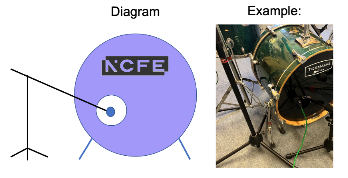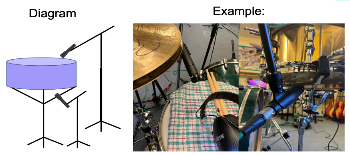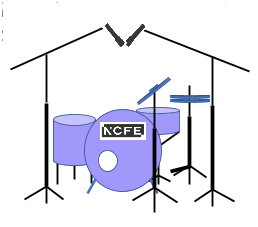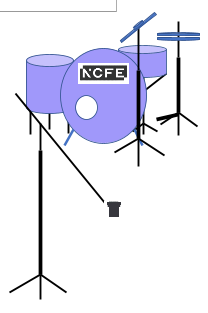Drum Recording
1/11
Earn XP
Name | Mastery | Learn | Test | Matching | Spaced |
|---|
No study sessions yet.
12 Terms
What microphone will you need to record a kick drum?
Microphone type: Dynamic
Polar pattern: Cardioid
Stand: short stand
What microphone will you need to record a snare drum (top)?
Microphone type: Dynamic
Polar pattern: Cardioid
Stand: large stand
What microphone will you need to record a snare drum (bottom)?
Microphone type: Dynamic
Polar pattern: Cardioid
Stand: large stand
What microphone will you need to record overhead (left)?
Microphone type: Condensor
Polar pattern: Cardioid
Stand: large stand
What microphone will you need to record overhead (right)?
Microphone type: Condensor
Polar pattern: Cardioid
Stand: large stand
What microphone will you need to record room ambience?
Microphone type: Condensor or Dynamic
Polar pattern: Omnidirectional
Stand: short stand

Explain the kick drum microphone placement.
Place the microphone on the kick drum.
Placement:
Using the port hole to get inside the drum
Pointing at the beater
Roughly halfway inside

Explain the snare drum microphone placement.
Place the microphones on the snare drum.
Snare top placement:
Above the edge of the drum
Pointed towards the center
Snare bottom placement:
Below the snares
Pointed towards the center

Explain the overhead microphone placement.
Place the microphones overhead of the drum kit.
The microphones should be in an XY configuration.
You should use condenser microphones.
You should use a cardioid polar pattern.
What is the purpose of a room microphone?
It’s placed further away from the drum kit.
The idea of this microphone is to capture the natural ambient reverb of the space.
Using an omnidirectional polar pattern is useful to
equally capture the sound of the room.

Explain the room microphone placement.
Place the microphone further away from the drum kit in the room.
You can use a condenser or dynamic microphone.
You can use a cardioid or omnidirectional polar pattern.
How should a drum recording be monitored?
The drummer needs to monitor the backing track/other instruments/click track.
The engineer needs to be able to monitor through studio monitors (speakers) to listen back to takes or they could use headphones.
The performer should use close-back headphones to reduce the bleed/spill into the microphone(s).
The engineer will also need to use a talkback microphone to be able to communicate with the performer during recording.